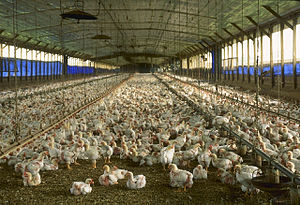 |
| Free Range Chickens being fed (Photo credit: Wikipedia) |
Part 1: A Chickens Life
The first in a multi-part series comparing modern poultry farms to the more
traditional Free Range Chicken. Modern farming methods have not only
removed the humanity from poultry farming,
they have taken the nutritional
advantages of one of our healthiest
protein sources and turned it into just another form of fat for us to poison ourselves with.
Free Range Chickens
Chicken raised by traditional farming methods were allowed
to roam. My Grandmother called them yard birds and that is what they were.
These chickens were raised in an open
coop and allowed to free-range during
the day. They foraged for the
majority of their food consuming insects and grasses as well as the little food
that was given to them. In return these chickens
fertilized the soil in the yard and kept the insect population under control.
Broiler House Prisons
 |
| Chickens being transported in trucks, presumably for slaughter. (Photo credit: Wikipedia) |
Modern farming methods
have done away with these free-range
chickens. Chickens are packed
into long closed Chicken Houses. In
the European Union and
Australia these are generally 150 meters long, 15 meters wide and will
house 40,000 to 60,000 chickens. In
the United
States houses vary greatly in size but a recommended flock density of one bird per square foot is the norm.
Lights burning overhead are kept dim to encourage calm in
the flock. The chickens live in a
perpetual twilight broken only by the 4 hour rest period they receive each day
for sleep. This is the minimal amount of rest that, research has
found, will allow the broilers to
survive till harvest. The other twenty hours of their day is spent feeding and
drinking. Food is never more than 3 meters from any chicken.
Chickens will
spend five weeks (average 5lb weight), their entire life, in these living
conditions. Twenty hours a day in twilight. 4 hours a day in darkness and
twenty-four hours a day standing in their own filth. Chicken houses are not, normally, cleaned during a growing cycle.
 |
| A commercial meat chicken production house in Florida, USA (Photo credit: Wikipedia) |
This form of poultry
farming has been indicated as a NPS (None Point
Source) polluter by the USEPA (United States Environmental Protection
Agency). It is considered a major contributor to air, water, and soil
pollution. If you have ever lived close to one of these Poultry farms you won't doubt any of these charges.
Free Range or Broiler House
This article was just to introduce you to a subject I plan
to cover in-depth. There will be more to come. Mental and physical health,
environmental and ecological impact, Food cost and nutrition all these subjects
come into play when discussing this subject and hopefully I will be able to
share some useful information on all of them. Making educated decisions is the
responsibility of each of us. I don't judge another person's choices. I simply
hope to give you the information you need to make those decisions.


I like your "matter of fact" approach to this subject. It is an emotional one for me. I'm vegetarian, but do eat eggs. They are organic- free range. There is little more I can say without becoming emotional and judgmental.
ReplyDeleteGreat article again Gregory!